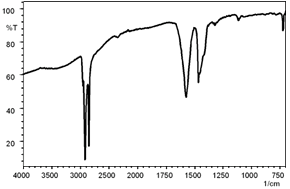Q: Can you tell me why the spectrum baseline is curved?

Microscope Transmission Spectrum of Magnesium Stearate
A : The IR spectrum baseline may be curved due to the reasons below.
(1) Effects of scattering (transmission method, specular reflection method, etc.)
The baseline of the transmission spectrum may drop off at the left (%T display) if the sample has a rough surface or contains inorganic compound powder. This is caused by scattering of the infrared light at the sample surface or interior, and this effect is greater for the shorter wavelength. Consequently, an IR spectrum affected by scattering drops more (%T display) towards the short wavelength (high wavenumber) end.
The diagram at the right shows the microscope transmission spectrum of magnesium stearate that drops off to the left due to the effects of scattering.

ATR Spectrum of Butyl Rubber Containing Carbon Black
(2) Effects of carbon black, etc. (ATR method)
ATR spectra of black rubber and other samples containing carbon black show a baseline sloping down to the right (%T display). Carbon black displays absorption over the entire region from 4000 to 400 cm-1. However, when using the ATR technique, the effect of carbon black becomes greater with deeper light penetration at the long wavelength (low wavenumber) end. This results in a spectrum where the baseline descends at the right end (%T display).

Transmission Spectra of Polystyrene and Polypropylene
(3) Effects of interference fringes (transmission method, specular reflection method, etc.)
When measuring the transmission spectrum of a sample with a smooth surface such as film, the baseline may appear as a regular sine wave pattern. These are interference fringes due to multiple reflections of light within the sample. The diagram at the right shows the transmission spectra of polystyrene and polypropylene affected by interference fringes. The fringe length differs according to sample thickness and refractive index.
(4) Effects of background measurements
In specular reflectance measurements of coatings on metals, the baseline will be affected if conditions differ between the surface of the reference sample and measurement target (measurement position). For example, if the surface of the reference sample is rougher and more curved than the sample, the spectrum baseline shows a transmittance exceeding 100%T.






